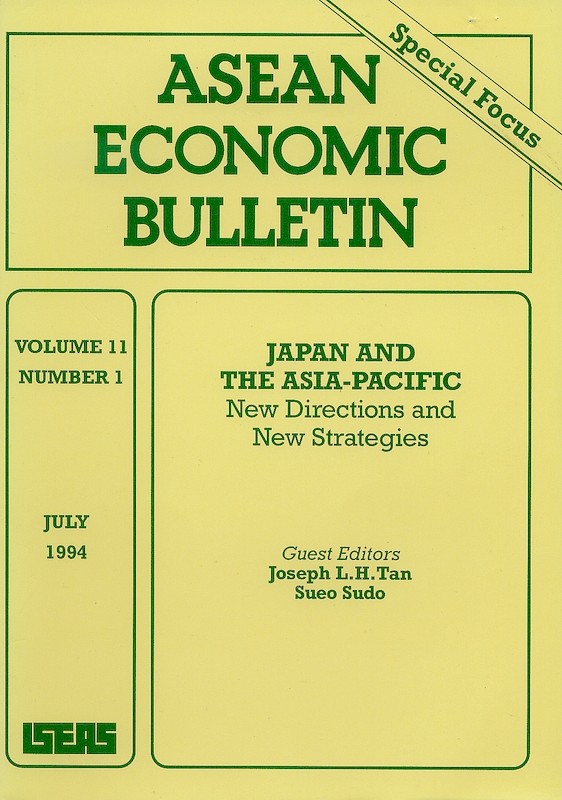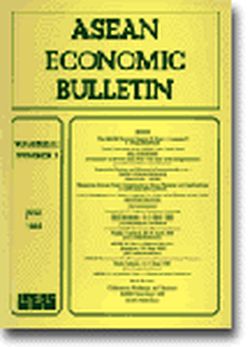ASEAN Economic Bulletin Vol. 11/2 (Nov 1994)

Date of publication:
November 1994
Publisher:
Institute of Southeast Asian Studies
Number of pages:
130
Code:
AE11/2
Contents
-
Preliminary pages
- ARTICLES
-
The Emergence of the Middle Class in ASEAN Countries, by Helen Hughes, Berhanu Woldekidan, authors see abstractMiddle classes are not simply middle income groups, but have cultural, social, political, and economic characteristics that make substantial contributions to development. Although middle classes are difficult to define precisely, it is clear that the middle-class population increases exponentially as a proportion of total population with economic growth. Estimates of the size of the middle class have been made for the ASEAN countries. Taking the growth of the middle class into account in national policies can facilitate development in housing, health, education and the environment.
-
A Case for Further Collaboration between the EU and ASEAN, by Robert L Curry, Jr., author see abstractMuch of the complementary and harmonious economic policy positions enjoyed by Southeast Asian and other Pacific Basin partner countries are similar to those shared by members of the European Union (EU) and the Association of Southeast Asian Nations (ASEAN). However, institutionally ASEAN has established a fuller set of collaborative arrangements within the broader Pacific Basin than it has with Europe. As a consequence, in order to create a more level global playing field with respect to mutual market access, a case for enhanced collaboration between the EU and ASEAN can be made. Certain ASEAN and other Pacific Basin country initiatives can offer guidelines to broader European and Southeast Asian policy-making.
-
Economic Implications of NAFTA for ASEAN Members: A Disaggregated Approach, by Michael G Plummer, Pearl Imada Iboshi, authors see abstractAs the United States is a critical trade and investment partner for the Association of Southeast Asian Nations (ASEAN) member countries, the North American Free Trade Agreement (NAFTA) is of significant concern to the region. Studies using computational general equilibrium models and other economy-wide approaches to the economic implications of NAFTA generally show minor effects on non-partners, ASEAN countries included. However, these small effects on aggregate output could mask important sectoral effects on export industries deemed important to the economic development of individual ASEAN countries. This article takes a disaggregated approach to focus on NAFTA's potential trade diversion in sensitive and leading sectors of the ASEAN countries. It is found that significant trade and investment diversion will occur in a number of important sectors, in more traditional manufactured industries such as textiles and clothing, as well as in rapidly-growing sectors characterized by higher levels of technical sophistication such as transistor values and other electric components. The possibility of investment diversion and other effects of NAFTA for ASEAN are also discussed, and policy options for ASEAN are explored.
-
The Employment Challenge Facing Indonesia: Outlook and Lessons from ASEAN Neighbours, by Ozay Mehmet, author see abstractIndonesia's New Order has been notable for steady economic growth, especially in channeling oil revenues into programmes for food self-sufficiency, population control and, in the 1980s, structural adjustment and economic liberalization in an effort to diversify the economy with export-led industrialization. However, there is a growing problem of labour market force, currently estimated at 2.2 million annually. Starting with the 1993 State Guidelines (GBHN), Indonesian planning and policy are now at a crossroad, shifting from production targets towards employment creation and human resource development as the key thrusts of the Second Perspective Plan (19942018) commencing with Repelita VI (1994-98). This article examines the prospects and constraints relating to Indonesia's employment challenge, in particular by drawing lessons from the experience of Malaysia and Singapore.
-
The Role of the Private Sector in Health Services: Lessons for ASEAN see abstractDeveloped and developing country governments look to privatization as a mechanism for increased efficiency in health services and as an avenue to financial relief for public-sector health programmes. Privatization takes the form of rational public pricing policy, contracting of private vendors, transfer of ownership to private and quasi-public entities, and termination of public activities. The provision of curative services, medical education, and the production of medical supplies are prime areas for private-sector expansion. The public sector should continue to take primary responsibility for financing and delivery of key preventive and promotional services, including maternal and child health care, immunization services, and general control of contagious diseases. In addition, developing country governments must lead also lead in providing public health education, health information, and health-sector regulation. Moreover, the public sector must continue and increase its efforts to safe-guard the welfare of underprivileged and low-income beneficiary populations while pursuing a privatization policy. In critical areas such as the control of human immunodeficiency virus and treatment of conditions related to acquired immunodeficiency syndrome, broadly based co-operative efforts involving the public sector, the private sector, and non-governmental organizations are necessary to meet the health needs of developing member countries.
-
SHORT PAPERS, NOTES, AND COMMENTS: Why ASEAN Co-operation Cannot Work as a Model for Regionalism Elsewhere A Reply, by Jorn Dosch, Manfred Mols, authors
-
SHORT PAPERS, NOTES, AND COMMENTS: On ASEAN Co-operation A Rejoinder, by Hans C Blomqvist, author
-
DOCUMENTATION: Joint Press Statement of the 26th Meeting of the ASEAN Economic Ministries, in Chiangmai, Thailand, 22-23 September 1994.
-
DOCUMENTATION: Joint Declaration of the 11th ASEAN-EU Ministerial Meeting, in Karlsruhe, Germany, 22-23 September 1994.
-
DOCUMENTATION: Joint Ministerial Statement at the Meeting of APEC Ministers in Charge of Trade, in Jakarta, 6 October 1994.
-
DOCUMENTATION: Press Communique on Private Flows to Developing Countries Increase, But Aid Flows Grow Slowly
-
DOCUMENTATION: IMF Interim Committee's Madrid Declaration on Co-operation to Strengthen Global Expansion
-
BOOK REVIEW: From Reform to Growth: China and Other Countries in Transition in Asia and Central and Eastern Europe, edited by Chung H Lee and Helmut Reisen, by Christopher Lingle, author
-
BOOK REVIEW: Technology Management and International Business: Internationalization of R&D and Technology, edited by Ove Grandstrand, Lars Hakanson, and Soren Sjolander, by Eric D Ramstetter, author
-
BOOK REVIEW: The Control and Management of Government Expenditure: Issues and Experience in Asian Countries, by United Nations Development Programme and Economic and Social Commission for Asia and the Pacific, by Jose Edgardo Campos, author
-
BOOK REVIEW: Indonesian Assessment 1993 Labour: Sharing in the Benefits of Growth, edited by Chris Manning and Joan Hardjono, by Reza Yamora Siregar, author
-
Conferences, Workshops and Seminars
-
ASEAN Chronology 1994
-
Some Recent Publications



